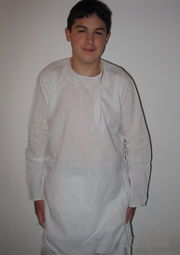Kurta


A kurta (Persian/Urdu: کُرتا, Hindi: कुरता, pronounced [ˈkʊrta]; also kurti for a shorter version) is a traditional item of clothing worn in Afghanistan, Bangladesh, India, Pakistan, Nepal, and Sri Lanka. It is a loose shirt falling either just above or somewhere below the knees of the wearer, and is worn by both men and women. They were traditionally worn with loose-fitting paijama (kurta-paijama), loose-fitting salwars, tight-fitting churidars, or wrapped-around dhotis;[1] but are now also worn with jeans.[2] Kurtas are worn both as casual everyday wear and as formal dress. A kurta is also referred to as a panjabi, (usually spelled lower-case) in Bengal, Sri Lanka, Britain, and Canada.[3]
Women often wear kurtis as blouses, usually over jeans.[2] These kurtis are typically much shorter than the traditional garments and made with a lighter materials, like those used in sewing kameez. Men also wear kurtis, typically over jeans.
Imported kurtas were fashionable in the 1960s and 1970s, as an element of hippie fashion, fell from favor briefly, and are now again fashionable. South Asian women may also wear this Western adaptation of South Asian fashion.
Formal kurtas are usually custom-made by South Asian tailors, who work with the fabric their customers bring them. South Asians overseas and Westerners, can buy them at South Asian clothing stores or order them from web retailers.
Contents |
Styles
A traditional kurta is composed of rectangular fabric pieces with perhaps a few gusset inserts, and is cut so as to leave no wasted fabric. The cut is usually simple, although decorative treatments can be elaborate.
The sleeves of a traditional kurta fall straight to the wrist; they do not narrow, as do many Western-cut sleeves. Sleeves are not cuffed, just hemmed and decorated.
The front and back pieces of a simple kurta are also rectangular. The side seams are left open for 6-12 inches above the hem, which gives the wearer some ease of movement.
The kurta usually opens in the front; some styles, however, button at the shoulder seam. The front opening is often a hemmed slit in the fabric, tied or buttoned at the top; some kurtas, however, have plackets rather than slits. The opening may be centered on the chest, or positioned off center.
A traditional kurta does not have a collar. Modern variants may feature stand-up collars of the type known to tailors and seamstresses as "mandarin" collars. These are the same sort of collars seen on achkans, sherwanis, and Nehru jackets.
 Close up of Chikan embroidery and wood (sandalwood) cuff links style buttons on kurta |
A modern shin-length embroidered silk kurta |
 Close up of knot-and-loop button for a "side open" Kurta |
 Side-opening Chikan kurta with semi-precious-stone cuff-links-style buttons |
 Close up of semi-precious-stone cuff-links-style buttons |
 Close up of side-open silk kurta with Chikan embroidery |
Material
Kurtas worn in the summer months are usually made of thin silk or cotton fabrics; winter season kurtas are made of thicker fabric such as wool (as in Kashmiri kurtas) or Khadi silk, a thick, coarse, handspun and handwoven silk that may be mixed with other fibers.
Kurtas are typically fastened with tasseled ties, cloth balls and loops, or buttons. Ready-made kurtas often avoid the use of horn buttons, in deference to Hindu sentiments; such buttons are frequently made from cow or buffalo hooves or horns. Buttons are often wood or plastic. Kurtas worn on formal occasions might feature decorative metal buttons, which are not sewn to the fabric, but, like cufflinks, are fastened into the cloth when needed. Such buttons can be decorated with jewels, enameling, and other traditional jewelers' techniques.
Decoration
South Asian tailors command a vast repertoire of methods, traditional and modern, for decorating fabric. It is likely that all of them have been used, at one time or another, to decorate kurtas. However, the most common decoration is embroidery. Many light summer kurtas feature Chikan embroidery, a speciality of Lucknow, around the hems and front opening. This embroidery is typically executed on light, semi-transparent fabric in a matching thread. The effect is ornate but subtle.
History
 Muslim scholar in kurta, East Bengal (Bangladesh), 1860 |
 Muslim Pahari (Hill) women in kurtis, Kashmir, 1890. |
 Hindu Dom man in short kurta, East Bengal (Bangladesh), 1860. |
Etymology
The word "kurta" is a borrowing from Urdu and Hindi,[4] and originally from Persian (literally, "a collarless shirt")[5] and was first used in English in the 20th century.[1]
Notes
- ↑ 1.0 1.1 Oxford English Dictionary, Second Edition. 1989. The first use is attributed to W.G. Lawrence in T. E. Lawrence, Home Letters, 1913, "Me in a dhoti khurta, White Indian clothes."
- ↑ 2.0 2.1 "Regal chic", The Telegraph, Calcutta, April 24, 2004. Quote: "The first sequence was a range of traditional saris in silk and cotton, moving on to kurtis and jeans and short kurtas in silk and georgette."
- ↑ Oxford English Dictionary, Draft version September 2008, "punjabi, panjabi: Usu. with lower-case initial. Esp. among people of South Asian descent: a kind of loose shirt or tunic; a kurta."
- ↑ Merriam Webster: Kurta
- ↑ McGregor, R. S. (ed.). 1993. The Oxford Hindi-English Dictionary. Oxford University Press. 1083 pages. ISBN 0-19-563846-8.
References
- Tarlo, Emma. 1996. Clothing Matters: Dress and Identity in India. Chicago: University of Chicago Press. 382 pages. ISBN 0-226-78976-4
- Bhandari, Vandana. 2004. Costumes, Textiles, and Jewellery of India. Mercury Books. 192 pages. ISBN 1-904668-89-5
|
|||||||||||